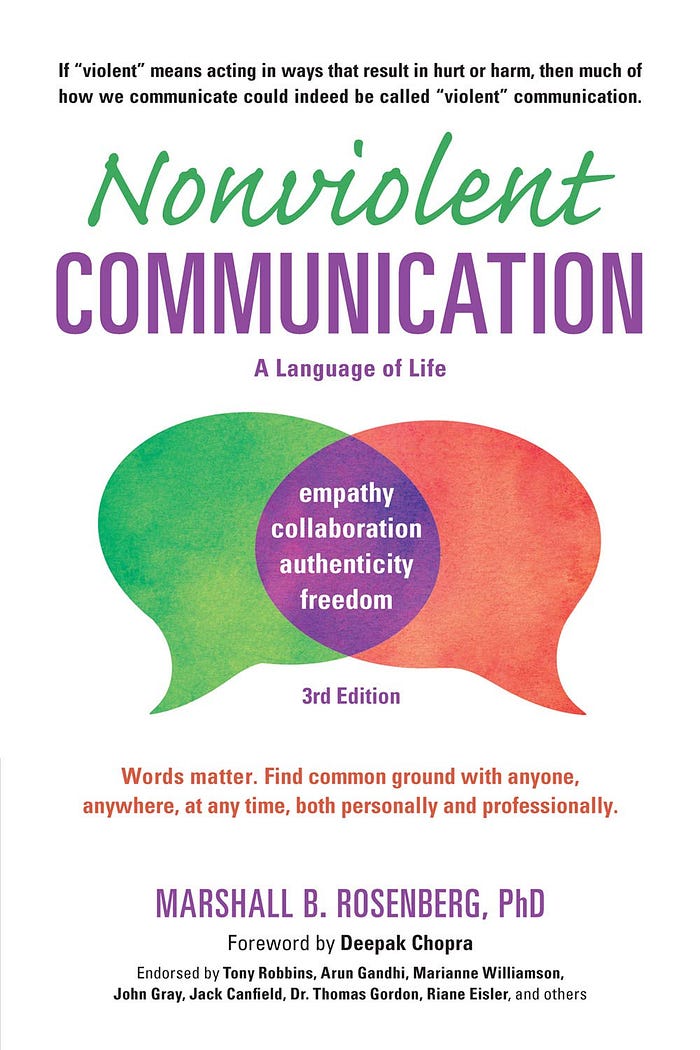Book Summary : Nonviolent Communication
Leading people is, hands down, the most challenging thing I have ever worked on in a professional setting. As the impact of leadership over individual contribution increases how I communicate is top of my mind as an area to improve.
When I reflect on the most painful mistakes I have made in my short time leading Vow it comes down to communication. Unlike an individual contributor role where the thing you have on is either done or not done, dealing with the nuance and uncertainty of human emotions is where the challenge lies. I am actively looking to expand my communication toolkit to be as effective as possible.
Nonviolent communication has been mentioned to me by a few people over the past two years. It falls into this funny space somewhere between self help, pop psychology and management books. Nonviolent Communication is certainly not the style of book I would normally pick up, chock full of language about ‘from the heart’ and interspersed with poetry, but I am glad I did.
1 Paragraph Summary
Nonviolent Communication is a simple four step approach to communicating effectively: Observe the actions that affect our wellbeing, say how we Feel in relation to this, described our Needs that create this and the concrete actions we Request. It sound deceptively simple, but each step of this flies in the face of much of our social conditioning. Beyond that the book goes into how to more effective understand, feel and respond to our own feelings (especially anger) and receive information more empathetically.

The first half of the book focuses outwardly. On the actions and activities an individual can undertake to improve how they communicate and perceive the world. This delves into the four steps of Nonviolent Communication:
Observing
Observing the behaviours of others without judgment is hard. Have you ever found yourself evaluating someone’s behaviour with wide sweeping judgment? Maybe you described someone as ‘lazy’ or ‘entitled’.
This is something I know I do, and frequently see others doing. It’s an incredibly easy habit to slip into. This book describes the challenge of observing in a way that is specific to time and context rather than a judgment on an individual.
A simple example used in the book: ‘Hank hasn’t scored a goal in 20 games’ provides a specific context (scored a goal) and time (20 games) rather than a broad judgment ‘Hank is bad at soccer’.
This is an easy skill to practice that removes a lot of the emotion and implied judgment from communication.
Feeling
Many of us, myself very much included, have a large vocabulary for things we perceive as logical or rational and a far smaller vocabulary for the things we feel.
By expressing a small amount of vulnerability, by being open with what we are feeling conflicts can often be avoided or significantly de-escalated. For many of us (me!) this requires two separate skills:
- Establishing a broader vocabulary of feelings
- Being open to the vulnerability that comes with sharing these with other people

Needing
Others will say or do things which stimulate our own feelings but are never the cause of them. The cause of these feelings is internal, an expression of our underlying needs.
When something negative is communicated to us we have a few ways in which we can respond:
- Blame ourselves
- Blame others
- Sense our own feelings and needs
- Sense the feelings and needs hidden in the other persons negative message
Often when we hear criticism it is a direct and alienated expression of our own needs and values. Hearing the broad criticism ‘you need to be more professional’ can easily be interpreted as a direct attack against your own need to feel valued. Hearing this it is easy, natural and human to respond confrontationally.
According to the book more directly we connect our needs with our feelings the easier it becomes to respond compassionately. Whether we are the recipient or the source of the criticism.
Revealing our own needs is a scary thing to do. We are socialised to internalise, and often put aside these needs in service of others.
Requesting
The last part of the nonviolent communication framework addresses the (obnoxiously phrased) ‘what we would like to request of each other to enrich our lives’.
As the book digs into it the topic is much simpler than it seems: the message we send is not the message the other party will receive. There are a few ways to ensure this message is received well:
- Using specific language — avoiding ambiguity, vague or abstract phrasing so the receiver can hear what is being said.
- Use positive language: focus on what we are rather than are not.
- Avoid demands wherever possible. Demands are heard when the listener believes they will be blamed or punished for not complying. This can be managed by indicating our own desire for them to do so only if they can do so willingly.
The second half of the book focuses inwardly, on how we can respond to hear others effectively and compassionately.
Empathy
Empathy, put simply, is a respectful understanding of what others are experiencing. It does not require advice, response or reassurance, but the ability to be present to understand the experience of another.
In the book they recommend being less sensitive to the words the other users and listening for feelings, needs, observations and requests. Reflecting these back to show we have understood them. This gives the person space to fully express themselves before we try to solve problems together.
Empathy is reflected by others, we need to be generous with our own so others can give empathy back. If you are feeling yourself become defensive:
- Stop, breathe and give yourself empathy,
- ‘Scream nonviolently’, or,
- Take time out
Anger
Anger is a normal emotion we all feel, to communicate non-violently we must first understand that blaming and punishing others is a superficial representation of our anger. To fully express anger we must separate the other person from the responsibility of our anger.
To fully express anger:
- Stop and breathe
- Identify judgmental thoughts
- Connect with our needs
- Express our feelings and unmet needs
Now for the hard part, applying this in day to day life!
